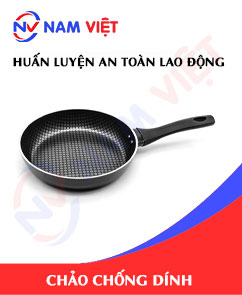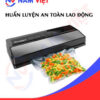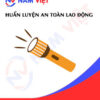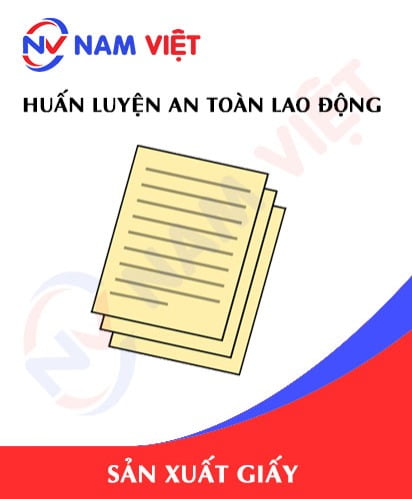Occupational Safety Training in Non-Stick Pan Manufacturing
99,000 ₫
Note: The above price is calculated for one person, the price may fluctuate depending on the number of trainees participating in the course and depending on market movements. For more accurate pricing support, please refer to the quotation table or contact our consulting staff directly.
Occupational safety is an important issue in non-stick pan manufacturing factories and needs to be addressed promptly to ensure the health and safety of workers, and to enhance the reputation of businesses. The Occupational safety training course is one of the effective solutions to raise awareness about accident prevention for workers participating in non-stick pan manufacturing.
Table of Contents
Toggle1. Overview of Non-Stick Pans
a. What is a Non-Stick Pan?
A non-stick pan is a type of pan coated with a non-stick surface that prevents food from sticking and makes cleaning easier after use. Common non-stick coatings include PTFE (polytetrafluoroethylene) or ceramic. Non-stick pans are typically used for frying, sautéing, cooking, roasting, and other recipes. In addition to pans, other kitchen utensils such as pots and woks can also have non-stick coatings.

b. Machinery for Non-Stick Pan Production
The production process of non-stick pans generally includes steps such as material preparation, mixing, pressing, heating, coating with non-stick material, and packaging. Common machinery used in the production process includes:
- Press machines: to shape pans from flat steel sheets.
- Stamping machines: to create floral patterns, folds, or other designs on the pan surface.
- Furnaces: to heat the pans, enhancing hardness and durability.
- Coating machines: to apply a non-stick layer on the pan surface.
- Packaging machines: to package the pans after production is completed.
Other equipment such as cutting machines, surface processing machines, cleaning machines, and quality inspection machines are also used to ensure product quality.

c. Non-Stick Pan Manufacturers in Vietnam
In Vietnam, some well-known non-stick pan brands include:
- Kangaroo: a brand of Kangaroo Trading and Construction Co., Ltd., established in 1995, known for high-quality products in diverse styles, sizes, and price ranges.
- Lock&Lock: a brand of Lock&Lock Co., Ltd., headquartered in South Korea and manufactured in Vietnam. Lock&Lock non-stick pans are famous for elegant designs, variety, and high quality.
- Sunhouse: a brand of Sunhouse Vietnam Co., Ltd., established in 2008, offering a wide range of products in materials, designs, and sizes to meet customer demands.
- Happy Cook: a brand of Hong Ha Food Co., Ltd., featuring non-stick pans with many convenient features, diverse models, and prices suitable for various customer groups.
- Tefal: a brand of the SEB Group headquartered in France, manufactured in Vietnam. Tefal non-stick pans are known for high quality, useful features, and modern design.
d. Specific Jobs in a Non-Stick Pan Factory
Group 1
- Chief Executive Officer, Deputy CEO, and department heads in a non-stick pan production factory.
Group 2
- Safety officers: manage factory safety, design safety procedures, supervise and ensure employees follow safety protocols.
Group 3
- Material fabrication and processing: raw materials like aluminum, stainless steel, titanium, or alloys are cut, bent, and processed to create pan parts and components.
- Pan shaping: parts and components are welded or assembled to form the shape of the pan.
- Non-stick coating: after forming, the pan is coated with non-stick materials such as dipping or spraying. This significantly reduces oil usage during cooking and prevents sticking.
- Quality inspection: before packaging and shipping to consumers, pans are inspected to ensure they meet quality and safety standards.
- Packaging and shipping: finished pans are packaged and prepared for distribution to stores and dealers.
Group 4
- Office, service, sales, and marketing roles.
- Production management, quality management, human resources, material management, financial and accounting management.
- Research and development of new products, designing packaging and product samples.

2. Overview of Occupational Safety Training for Non-Stick Pan Production
This article focuses on Group 3 because Group 3 directly participates in production and faces the highest occupational safety risks. For information about other groups, see here.
a. What is Group 3 Occupational Safety Training?
- Group 3 occupational safety training equips workers with awareness and prevention measures for workplace accidents.
- The training course helps workers identify hazards, prevent risks, and reduce workplace accidents while performing their duties.
REGISTER FOR OCCUPATIONAL SAFETY TRAINING SERVICE
b. Training Duration
Initial Occupational Safety Training
- Total training time is at least 24 hours, including testing time.
- 8 hours of theory on policies and laws regarding occupational safety and hygiene
- 8 hours of theory on basic knowledge of occupational safety and hygiene
- 4 hours of theory on specialized training content
- 2 hours of practical training on specialized content
- 2 hours of final theoretical test
The training center schedules sessions depending on workers’ availability. Typically, there are 6 training sessions over 3 days if continuous scheduling is possible.
Periodic Occupational Safety Training
- Before the occupational safety card expires, workers must undergo periodic occupational safety training, with training duration at least 50% of the initial training duration.
Explanation: the total periodic training time is at least 12 hours, including testing. After completing the periodic training and passing the test, workers are reissued or extended their occupational safety card.
c. Training Content
| No. | TRAINING CONTENT | TRAINING DURATION (HOURS) | |||
| Total | Including | ||||
| Theory | Practical | Test | |||
| I | Policy and occupational safety law system | 8 | 8 | 0 | 0 |
| 1 | Overview of the legal framework on occupational safety and hygiene. | 6 | 6 | ||
| 2 | System of standards and technical regulations on occupational safety and hygiene. | 1 | 1 | ||
| 3 | Specific regulations of state management agencies regarding safety and hygiene when constructing, expanding, or renovating facilities for production, use, storage, and inspection of machinery, equipment, materials, or hazardous substances. | 1 | 1 | ||
| II | Basic knowledge of occupational safety and hygiene | 8 | 8 | 0 | 0 |
| 1 | Basic knowledge of workplace hazards and risks. | 4 | 4 | ||
| 2 | Methods to improve working conditions. | 1 | 1 | ||
| 3 | Safety culture in production and business. | 1 | 1 | ||
| 4 | Rights and obligations of employers and employees; safety and hygiene policies; roles of safety officers. | 1 | 1 | ||
| 5 | Safety rules, signs, guidance, use of safety equipment, personal protective equipment; skills in first aid, accident prevention, and occupational disease prevention. | 1 | 1 | ||
| III | Specialized training content | 6 | 4 | 2 | 0 |
| Comprehensive knowledge of machinery, equipment, hazardous substances; risk analysis and management for occupational safety; safe work procedures for machinery, equipment, and substances with strict safety requirements. | 6 | 4 | 2 | ||
| IV | Final occupational safety test | 2 | 2 | 0 | 0 |
| Total | 24 | 22 | 2 | ||
See more training content of the 6 groups
d. Occupational Safety Card
After completing occupational safety training and passing the test, workers will be issued an occupational safety card (commonly called Group 3 safety certificate).
The Group 3 safety card shows information such as name, date of birth, job, and working environment. It also includes training duration, red seal, and signature confirming course completion.
According to regulations on card issuance stated in Clause 2, Article 24 of Decree 44/2016/ND-CP, there are two cases:
- If the employer and employee have a labor contract, the employer must sign, stamp, and validate the safety card after the worker completes training from the occupational safety training unit and passes the test.
- If the worker is freelance or seasonal without a labor contract, the training unit must sign, stamp, and validate the safety card after the worker completes training and passes the test.

3. Identifying Hazards Affecting Workers in Non-Stick Pan Production
Some hazards that may affect workers in non-stick pan production include:
- Fire and explosion risk: The use of chemicals in pan production can create a fire or explosion risk if not handled and stored properly.
- Poisoning risk: Chemicals and additives used in non-stick pan production can pose health hazards to employees if overexposed or mishandled.
- Electric shock risk: If electrical equipment in the factory is not regularly maintained or lacks proper insulation and waterproofing, it can pose an electric shock hazard during production.
- Occupational accident risk: Machinery used in non-stick pan production, such as cutting machines and presses, can cause accidents if used improperly or not regularly maintained.
- Burn risk: Hot materials like metal and plastic in production can cause burns if protective equipment is not properly used.
- Slipping and tripping risk: Floors and surfaces in non-stick pan factories may be slippery, leading to slip and fall hazards for employees.
4. Common Occupational Accidents in Non-Stick Pan Production
Common occupational accidents in non-stick pan production may include:
- Hot burns: Pouring pan materials into molds can splash hot materials, causing burns to workers.
- Cut injuries: Metal cutting machines used in production can be dangerous if workers are not careful.
- Crushing hazards: Pans being transported or stacked may tilt or fall, creating a risk for workers.
- Machine-related injuries: Machinery can cause injuries if workers do not follow safety regulations.
- Chemical contamination: The use of toxic chemicals such as dyes or solvents can be hazardous to workers’ health if not handled correctly or without proper protective equipment.

5. Safety Measures When Participating in Non-Stick Pan Production
Safety measures for working in non-stick pan production include:
- Use of personal protective equipment: Workers should wear helmets, safety glasses, gloves, protective shoes, masks, oil vapor filters, etc., to protect their health.
- Occupational safety training: Factories should train employees on production techniques and safety measures.
- Equipment inspection and maintenance: Machinery and equipment should be regularly checked and maintained to ensure safe and effective operation.
- Use of safe materials: Materials used in production should be safe for employees and end-users.
- Monitoring the production process: Supervision ensures occupational safety, product quality, and customer requirements are met.
- Proper waste disposal: Factories should handle waste properly to protect the environment and employee health.
- Regular workplace environmental monitoring to collect and analyze harmful factors, reducing risks and preventing occupational diseases.
6. Benefits of Occupational Safety Training in Non-Stick Pan Production
An Toan Nam Viet provides businesses with the following benefits after completing occupational safety training courses in accordance with Decree 44/2016/ND-CP regarding occupational safety and hygiene:
- Workers can identify potential hazards and take preventive measures to avoid accidents.
- Businesses can establish risk prevention measures in production, operation, and maintenance processes.
- Reduce costs associated with workplace safety incidents.
- Continuous production improves productivity and product quality.
- Compliance with labor safety laws minimizes legal risks.
- Enhances credibility and professionalism, improving company branding.
Nam Viet’s training programs help individuals prevent external hazards that could cause injury or even death.
REGISTER FOR OCCUPATIONAL SAFETY TRAINING SERVICE
7. Customer Feedback After Completing Occupational Safety Training in Non-Stick Pan Production
An Toan Nam Viet has years of experience supporting businesses across Vietnam, particularly in the southern provinces. This responsibility is extremely valuable, which is why our occupational safety training is increasingly professional. Our growth is fueled by positive feedback and suggestions from our clients. Below are testimonials from partners we have served.
See more customer interviews after using our services at An Toan Nam Viet
8. An Toan Nam Viet’s Occupational Safety Training Capability
An Toan Nam Viet is a reputable and quality occupational safety training center in Vietnam. Training sessions are continuously held at factories, workshops, or construction sites nationwide (in all 63 provinces of Vietnam).
REGISTER FOR OCCUPATIONAL SAFETY TRAINING SERVICE
Occupational Safety Training License
- An Toan Nam Viet has been inspected and certified by the Department of Safety under the Ministry of Labor, Invalids and Social Affairs, granting full qualification for occupational safety and hygiene training. This further reinforces our capacity for occupational safety training.

Training Materials and Lectures
- Before being applied in occupational safety training courses, materials are reviewed to ensure accuracy and effectiveness.
- Teaching methods of instructors are standardized according to An Toan Nam Viet standards, developed by experts in occupational safety and hygiene training to maximize learning efficiency for participants.
Facilities
- Controlling classroom factors that affect training enhances teaching efficiency and knowledge retention.
- Our training facilities include spacious classrooms meeting standards for area, lighting, and training equipment.
9. Nationwide Reputable and Quality Occupational Safety Training Center
At An Toan Nam Viet, we prioritize professional dedication in occupational safety training. Teaching workers how to protect themselves equips them with essential safety skills in their work and contributes to national development.
To ensure training effectiveness, we meticulously prepare every detail, from teaching tools and equipment to curriculum, materials, sound, and lighting.
Our occupational safety instructors are experienced experts who have conducted research on hazards in all industries and methods of prevention.
Lectures are practical, vivid, and easy to understand, helping workers absorb knowledge comfortably. All content strictly adheres to Decree 44/2016/ND-CP.
Participants gain awareness of hazard prevention and self-protection, applying knowledge practically in their work.
Our training center is proud to provide reputable, professional occupational safety training with advantages including:
- Competitive training costs without compromising quality.
- Flexible training schedules to match company production plans.
- Fast certification procedures compliant with legal regulations.
- Instructors with extensive experience in the field.
- Controlled classroom environment to maximize learning efficiency.
- Curricula tailored to workplace safety requirements in enterprises.
- Dedicated and professional service to support clients accurately and quickly.

10. Additional References for Occupational Safety Training in Non-Stick Pan Production
- Occupational safety materials for non-stick pan production
- Occupational safety training material set
- Occupational safety training test set
- Occupational safety training curriculum for non-stick pan production
- Occupational safety multiple-choice test for non-stick pan production
1 review for Occupational Safety Training in Non-Stick Pan Manufacturing
No comments yet















namchinh.haiphong341
Dịch vụ huấn luyện an toàn lao động rất tốt nhé, giảng viên dạy rất sinh động dễ hiểu!